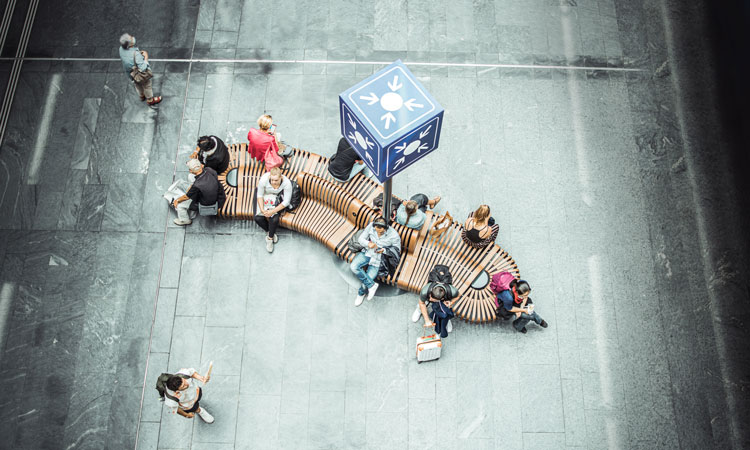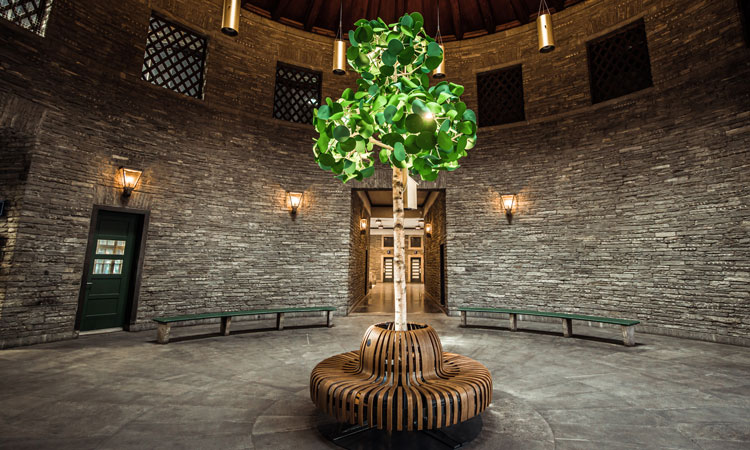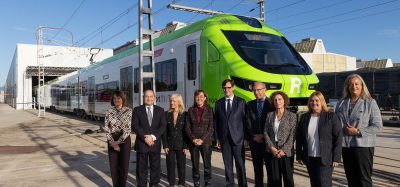“People consider a train station to be more than just the start or end of a rail journey”
Posted: 15 July 2021 | Christian Fricker, Global Railway Review, Green Furniture Concept | No comments yet
In an interview for Global Railway Review, Christian Fricker, Train Station Concept Specialist and Senior Project Manager at the Swiss Federal Railways (SBB), shares opinions on the importance of station design in improving the passenger experience.


To what extent is the role of station design important in improving the passenger experience at train stations?
Railway stations are central places of public life, so naturally their design is very important. People consider a train station to be more than just the start or end of a rail journey.
A robust design is essential for coping with the hundreds of thousands of passengers who use train stations every day. They must be very efficient areas to enable a smooth passenger flow, no matter how busy and thus help to create a seamless passenger experience. At Zurich main station alone, up to 460,000 people use the station every day (2019 figures).
SBB wants to meet the evolving needs of its customers by offering attractive stations, and that is why we are developing a new ‘dwell’ space concept.
SBB wants to meet the evolving needs of its customers by offering attractive stations, and that is why we are developing a new ‘dwell’ space concept. We no longer want our stations to simply be ‘waiting areas’. We aim to go beyond just making sure there is enough seating available; we also want to see our stations providing a wide range of services such as shopping, office spaces, doctors, pharmacies, and schools. Having good quality restaurants and bars is also very important – main train stations should have all the important amenities that are available away from station areas.
The significance of the railway station has already changed in recent years. They have changed from being a ‘transit’ area to now a ‘destination’. Railway stations, especially large ones, are most definitely known as ‘hubs’ these days and that is why it is important to make sure we are always tailoring them for the needs of the population.
Johan Berhin, Founder & Designer at Green Furniture Concept, comments: “The world is changing ever faster. The pandemic has accelerated this, but the journey of change has still just begun. Stations need to be flexible, furniture needs to be modular, and business models circular. Stations must also be able to shift to the ‘next level’ when it comes, whether that is hyperloop docking at the station, or incorporating self-driving cars. The travel experience is not something that can be added on the side any more, in the style “Let’s choose purple seats”. Railways are in the experience industry now, and wowed passengers are more satisfied, and also more loyal and receptive. The furniture companies that can deliver on this, in an efficient and ready to roll out way, will be the ones that get the orders from the networks.”
How does SBB measure and monitor the satisfaction rates of train station users?
Measuring the satisfaction not only of train passengers, but also of station users, is extremely important for SBB. To do this, we primarily use two different formats, namely the KuZuBA (to measure station customer satisfaction) and the KUZU (to measure train customer satisfaction). These surveys are conducted four times each year at 32 of our most important train stations.
Measuring the satisfaction not only of train passengers, but also of station users, is extremely important for SBB.
In addition, we have regular exchanges with our customers on the ‘customer board’ using the QMT (Quality Management Team) tool for measurement. The aim is to objectively measure the entire travel chain to ultimately improve customer satisfaction, service quality and understand efficient resource allocation. The QMT is carried out by 20 external, trained and independent test customers using a checklist.
The measurement includes the quality of stay (cleanliness, order, vandalism) and customer information (displays, announcements) at the station and on the train. Every year, more than 10,000 ‘measurements’ are taken on the train and more than 13,000 are taken at the station.
Carrying out these surveys allows us to gather lots of valuable information, including how many people use stations, the reason they are using the station, and how much money people spend whilst they are at a station. We also talk directly to the shops to understand how much turnover they make, if are they happy, and see how the station can be improved. We also keep an eye on other sectors including shopping malls and airports, considering what works well in those areas, and asking ourselves can we implement the same?


Why is it important for train stations to offer connectivity solutions for modern day passengers?
The majority of train passengers access, and use, tickets and journey information via their smart devices. Consequently, the ability for those customers to charge their device batteries not only on board trains, but also at stations, is becoming increasingly important. Equally important for passengers, is having access to Wi-Fi networks. This is especially true as we see stations becoming destinations where people spend lots of time, and far more than just an entry point to the railway network. SBB offers free Wi-Fi to customers at its busiest stations so that they can surf the web, work and synchronise e-mails whilst being at the station.
SBB offers free Wi-Fi to customers at its busiest stations so that they can surf the web, work and synchronise e-mails whilst being at the station.
Charging points at seating areas within stations is another significant aspect, which needs to be given greater consideration. A lot of seat manufacturers include electricity points underneath the seats, which makes them difficult to use. Personally, I think the electricity points should be directly integrated in easy-to-use areas, such as at shoulder height and not centrally located in a sitting area. We also need to consider that people want to be able to use their devices at the same time as they are being charged. As such, wireless charging / induction points are not very useful and also leave the user at much greater risk of theft, as they are not holding their phone.
We need to consider aspects such as these from the viewpoint of the passenger. What do our passengers need? What do our passengers expect? It’s by putting ourselves in their shoes, travelling through their eyes, that we improve not just connectivity, but the entire passenger experience as a whole.
How important is it for SBB’s train stations be eco-friendly and ‘green’ environments?
Being environmentally friendly and sustainable is one of our core corporate goals. In fact, SBB aims to be climate-neutral from 2030. To achieve this goal, we are significantly reducing our CO2 emissions by consistently reducing our energy consumption and using renewable energies. When procuring new products, we pay attention to sustainability, energy efficiency and recyclable components.
In 2012, we introduced areas at stations where customers can recycle their waste and this has been a huge success.
Having a clear recycling strategy is important for us. We work actively with customers to avoid waste, separate it and feed it into the Swiss recycling process.
In 2012, we introduced areas at stations where customers can recycle their waste and this has been a huge success. Since 2014, passengers have been able to separate paper, PET and aluminium for recycling at stations and do so effectively – our passengers dispose of almost 95 per cent of all recyclable materials correctly. Our passengers thus support different recycling processes and protect the environment.


Our younger customers, in particular those aged between 14 and 23, have told us they want greener stations with more sustainable offers, more atmosphere and more ambience.
We are currently working on making sure our stations are more ‘green’ with the use of solar panels, much more efficient heating systems, and areas that have nice flowers, plants and greenery – something our feedback has shown our younger customers feel is very important.
We also plan to use as much wood as possible in our station designs. Wood is a warm and sustainable material which is perfect for use at seating and waiting areas, and helps us to be seen as an eco-friendly organisation.
Johan Berhin, Founder & Designer at Green Furniture Concept, comments: “The station is the shop window to the most sustainable means of travel. And station furniture is like the clothes in that window. So dress up the station smartly, and clearly sustainably, using natural materials and natural shapes. People that have actively chosen to travel by train instead of the car or plane should feel that they are taken seriously in this decision, and that rail is the right choice.”
What does a post-COVID-19 future of station cleanliness look like for SBB?
To win back the trust of station users and to enable our passengers to feel comfortable and safe in the station environment again, it is important that we continue our cleaning regimes.
The safety of our clients and our colleagues is our top priority. This also applies to cleanliness. It goes without saying that SBB is incorporating its experience with COVID-19 into product and concept development.
There has been a different – but positive – shift in attitude towards cleaning and we have implemented more rigorous cleaning regimes at seating and benches, tables, ticket machines, hand rails etc.
To win back the trust of station users and to enable our passengers to feel comfortable and safe in the station environment again, it is important that we continue our cleaning regimes.
Adele Kamel, Director of Communications and Brand Strategy at Green Furniture Concept, comments: “Obviously, furniture needs to be sanitisable, in an efficient way. But not everyone knows that wood is also naturally antiseptic – think of wooden chopping boards. And that this effect can be either closed off, with varnish or paint, or strengthened with wax as surface treatment. Having a seamless seating line also answers well up to the current need for distancing, where the right distance between travelling entities can be taken while families can sit close together, seamlessly adjusting to regulations and passenger load. Using natural materials and natural shapes may also be the strongest way of building a nice environment in the stations, and a feeling of safety, for the recovery after the pandemic. Creating a welcoming feeling, and giving a place to breathe, and to feel that things are OK again.”
Related topics
Coronavirus/COVID-19, Passenger Experience/Satisfaction, Station Developments, Wi-Fi







